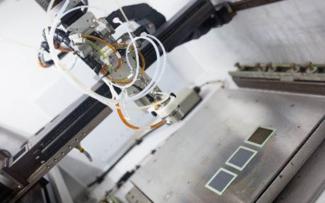Supporting domestic energy and technologies that produce efficient, affordable power with responsible stewardship of the environment are top priorities for NETL. Our researchers are examining new innovations that can provide clean, efficient energy from coal, natural gas, and oil. But the path from discovery to commercialization can take decades. So how do decision makers choose which breakthrough technologies have the potential to thrive in the commercial market and bring lasting benefit?
One specialty of NETL’s Research & Innovation Center – systems engineering and analysis – seeks to help answer that question. The Laboratory’s Energy Process Analysis team conducts techno-economic analyses to evaluate a technology’s economic feasibility.
Gregory Hackett, Ph.D., of NETL’s Energy Process Analysis team said techno-economic analyses are one of the most important tools during the development of innovative technologies, used to steer innovations toward commercial viability and maximized benefits. “Such analyses offer system-level estimates of emerging technology performance and cost entitlements at the commercial scale. This information helps make a case for investment in continued development and identifies areas where R&D efforts can achieve the most significant, economical improvements.”
Results obtained from NETL’s techno-economic analyses are used to guide research programs and portfolios. Results also ensure advanced technologies are on target to meet U.S. Department of Energy goals and provide the most benefit to the American people. Analysts developing techno-economic analyses conduct apples-to-apples comparisons of advanced technology options relative to state-of-the-art, and examine factors like power plant efficiency; capital and operating and maintenance costs; cost of electricity; emissions; and water consumption. techno-economics analyses also help identify performance and cost goals for novel technologies.
Hackett explained that a typical techno-economic analysis consists of multiple cases.
“Reference cases examine state-of-the art technology, like a power plant operating on bituminous coal. Advanced cases examine what would happen if a novel technology, whether a single piece of equipment or an entire power cycle, would replace the state-of-the-art technology in the reference plant,” Hackett said.
For example, in one baseline study for fossil energy plants, NETL compared the effect of applying carbon capture and storage technology to natural gas power plants and coal-fired power plants. To achieve 90 percent carbon capture, the analysis showed a 45 to 65 percent increase in the cost of electricity for a natural gas combined cycle plant and a greater than 75 percent increase for pulverized coal. Further analysis showed that lowering the capture rate for pulverized coal plants decreased the cost of electricity, but resulted in a higher cost of capture. The study determined that, to meet a goal of 90 percent capture, R&D should target performance improvements and reducing costs of fossil power generation.
Techno-economic analyses start with a baseline case, composed of state-of-the-art commercial technologies, often pulled from NETL’s “Cost and Performance Baseline for Fossil Energy Plants” series of reports. These reports contain detailed information on the type of fuel, generating capacity, emission controls, plant performance and cost, and other factors. Then, analysts develop a reference plant case that incorporates innovative technology(ies). Using computational modeling and simulation techniques, analysts assess how the new technologies would affect the performance and cost of power generation systems. With this information, decision makers are able to both evaluate and develop performance and cost targets for advanced technologies, and establish priorities for technology development.
One technology area that has been successfully guided by techno-economic analysis is solid oxide fuel cell (SOFC) research. SOFCs are highly efficient, virtually pollution-free devices that convert chemical energy of a fuel (e.g., hydrogen produced from coal) and an oxidant (air) directly into electrical energy. Since SOFCs produce electricity through an electrochemical reaction and not through a combustion process, they are much more efficient and environmentally benign than conventional electric power generation processes. Their inherent characteristics make them uniquely suitable to address the environmental and water concerns associated with fossil fuel-based electric power generation.
Techno-economic analyses provide a critical tool for the NETL SOFC Program as it works to address the technical issues facing commercialization of SOFC technology.
“We’ve conducted several studies, for example, an analysis of integrated gasification fuel cell systems and natural gas-fuel cell configurations,” Hackett said. “The results help focus R&D efforts to have the most impact. For example, it was determined that reducing stack degradation and improving operating life could have a large impact on the cost of electricity, so we know that is a research area we want to target.”
Degradation refers a continuous loss of performance over time. Guided with input from techno-economic analyses, NETL’s SOFC Program is investigating solutions to SOFC degradation, including microstructural visualization work that has created the largest high-resolution electrode reconstructions in the world to provide an in-depth look at how and why degradation occurs, and a groundbreaking new process for infiltrating SOFC electrodes with electrocatalytically active materials that improve the electrochemical performance of the cell, along with a commercially scalable process for deposition of the materials. Successes stemming from these endeavors are developing more robust cells and reducing cost – all leading to an effective and economical coal-based option for utility-scale power generation.
SOFCs are just one example. NETL’s techno-economic analyses are also benefitting a wide range of advanced power generation and pollutant control technologies, such as combustion turbines, chemical looping combustion, supercritical carbon dioxide (CO2) power cycles, and carbon capture systems. Analyses also provide insight into improving the performance and continued economic viability of existing coal-fired power plants.
Techno-economic analysis is a valuable tool to ensuring that innovations – from concept to market readiness – are pursuing the best route for success. While researchers are hard at work on discovering and development new technologies, information from these analyses ensure that research teams are applying their skills to the most worthwhile tasks provide assurance to investors and other stakeholders that the research is on a successful path toward commercialization.




